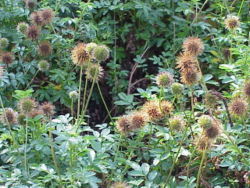Acaena: Difference between revisions
No edit summary |
No edit summary |
||
| Line 1: | Line 1: | ||
{{Inc| | |||
Acaena (from Greek word signifying thorn). Rosaceae. New Zealand Bur. Trailing, more or less evergreen plants used in rockwork and as ground cover under trees and between other plants. | |||
About 40 species of sub-shrubs or herbs of the southern hemisphere, allied to Agrimonia and Sanguisorba: lvs. unequally pinnate, alternate, the lfts. toothed or cut: fls. small, crowded in erect terminal spikes or heads; petals none; calyx 5-7-lobed, usually armed with spines; stamens 1-10, or even more: fr. an achene, 1 or 2 being enclosed in the hardened calyx. | |||
Acaenas are little grown in this country, but are prized in England as groundwork for dwarf spring-flowering bulbs, as trilliums; also useful in protecting native orchids and bog plants. Propagation is by cuttings, divisions and seeds. | |||
}} | |||
{{Taxobox | {{Taxobox | ||
| color = lightgreen | | color = lightgreen | ||
Revision as of 03:22, 20 June 2009
| Standard Cyclopedia of Horticulture |
|---|
|
Acaena (from Greek word signifying thorn). Rosaceae. New Zealand Bur. Trailing, more or less evergreen plants used in rockwork and as ground cover under trees and between other plants. About 40 species of sub-shrubs or herbs of the southern hemisphere, allied to Agrimonia and Sanguisorba: lvs. unequally pinnate, alternate, the lfts. toothed or cut: fls. small, crowded in erect terminal spikes or heads; petals none; calyx 5-7-lobed, usually armed with spines; stamens 1-10, or even more: fr. an achene, 1 or 2 being enclosed in the hardened calyx. Acaenas are little grown in this country, but are prized in England as groundwork for dwarf spring-flowering bulbs, as trilliums; also useful in protecting native orchids and bog plants. Propagation is by cuttings, divisions and seeds.
The above text is from the Standard Cyclopedia of Horticulture. It may be out of date, but still contains valuable and interesting information which can be incorporated into the remainder of the article. Click on "Collapse" in the header to hide this text. |
| Acaena {{{status}}} Fossil range: {{{fossil_range}}}
| ||||||||||||||||||||||||||||||||||||||||||||||||||||||||||||||||||
|---|---|---|---|---|---|---|---|---|---|---|---|---|---|---|---|---|---|---|---|---|---|---|---|---|---|---|---|---|---|---|---|---|---|---|---|---|---|---|---|---|---|---|---|---|---|---|---|---|---|---|---|---|---|---|---|---|---|---|---|---|---|---|---|---|---|---|
 Acaena novae-zelandiae foliage and various fruiting stages | ||||||||||||||||||||||||||||||||||||||||||||||||||||||||||||||||||
| Plant Info | ||||||||||||||||||||||||||||||||||||||||||||||||||||||||||||||||||
| ||||||||||||||||||||||||||||||||||||||||||||||||||||||||||||||||||
| Scientific classification | ||||||||||||||||||||||||||||||||||||||||||||||||||||||||||||||||||
| ||||||||||||||||||||||||||||||||||||||||||||||||||||||||||||||||||
| [[{{{diversity_link}}}|Diversity]] | ||||||||||||||||||||||||||||||||||||||||||||||||||||||||||||||||||
| {{{diversity}}} | ||||||||||||||||||||||||||||||||||||||||||||||||||||||||||||||||||
| Binomial name | ||||||||||||||||||||||||||||||||||||||||||||||||||||||||||||||||||
| {{{binomial}}} | ||||||||||||||||||||||||||||||||||||||||||||||||||||||||||||||||||
| Trinomial name | ||||||||||||||||||||||||||||||||||||||||||||||||||||||||||||||||||
| {{{trinomial}}} | ||||||||||||||||||||||||||||||||||||||||||||||||||||||||||||||||||
| Type Species | ||||||||||||||||||||||||||||||||||||||||||||||||||||||||||||||||||
| {{{type_species}}} | ||||||||||||||||||||||||||||||||||||||||||||||||||||||||||||||||||
| Species | ||||||||||||||||||||||||||||||||||||||||||||||||||||||||||||||||||
| See text. | ||||||||||||||||||||||||||||||||||||||||||||||||||||||||||||||||||
| [[Image:{{{range_map}}}|{{{range_map_width}}}|]] | ||||||||||||||||||||||||||||||||||||||||||||||||||||||||||||||||||
| Synonyms | ||||||||||||||||||||||||||||||||||||||||||||||||||||||||||||||||||
| {{{synonyms}}} |
Acaena is a genus of about 100 species of perennial herbs and subshrubs in the Rosaceae, native mainly to the Southern Hemisphere, notably New Zealand, Australia and South America, but with a few species extending into the Northern Hemisphere, north to Hawaii (A. exigua) and California (A. pinnatifida).
The leaves are alternate, 4-15 cm long, and pinnate or nearly so, with 7-21 leaflets. The flowers are produced in a tight globose inflorescence 1-2 cm diameter, with no petals. The fruit is also a dense ball of many seeds; in many (but not all) species the seeds bear a barbed arrowhead point, the seedhead forming a burr which attaches itself to animal fur or feathers for dispersal.
- Selected species
|
|
Invasive species
Some species have been introduced accidentally to other areas, attached to sheep's wool, and have become invasive species. A. novae-zelandiae, the bidibid from New Zealand, is the most commonly encountered species in Great Britain, where it is often abundant on coastal sand dunes, crowding out native vegetation and creating an often painful nuisance with the barbed burrs. In California, A. pallida, from New Zealand and southeast Australia, is similarly a problem species.